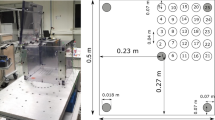Abstract
This paper numerically visualizes explosion phenomena in order to discuss blast wave characteristics with a two-dimensional axisymmetric room model. After the shock wave exits via an opening, the blast wave propagates into open space. In the present study, a parametric study was conducted to determine the blast wave characteristics from the room exit by changing the room shape and the mass of the high explosive. Our results show that the blast wave characteristics can be correctly estimated using a scaling factor proposed in the present paper that includes the above parameters. We conducted normalization of the peak overpressure curve using the shock overpressure at the exit and the length scale of the room volume. In the case where the scaling factor has the same value, the normalized peak overpressure curve does not depend on the calculation conditions, and the scaling factor describes the blast wave characteristics emerging from the current room model.









Similar content being viewed by others
References
Wu, C., Lukaszawicz, M., Schebella, K., Antanovskii, L.: Experimental and numerical investigation of confined explosion in a blast chamber. J. Loss Prev. Process Ind. 26, 737–750 (2013)
Anthistle, T., Fletcher, D.I., Tyas, A.: Characterisation of blast loading in complex, confined geometries using quarter symmetry experimental methods. Shock Waves 26, 749–757 (2016)
Sauvan, P.E., Sochet, I., Trélat, S.: Analysis of reflected blast wave pressure profiles in a confined room. Shock Waves 22, 253–264 (2012)
Pennetier, O., William-Louis, M., Langlet, A.: Numerical and reduced-scale experimental investigation of blast wave shape in underground transportation infrastructure. Process Saf. Environ. Protect. 94, 96–104 (2015)
Kingery, C.N., Bulmash, G.: Airblast Parameters from TNT Spherical Air Burst and Hemispherical Surface Burst. ARBRL-TR-02555, U.S. Army Ballistic Research Laboratory Aberdeen Proving Ground, MD (1984)
Skjeltorp, A.T., Jenssen, R., Rinnan, A.: Blast propagation outside a typical underground ammunition storage site. In: Proceedings of the Fifth International Symposium on Military Application of Blast Simulation, Stockholm (1977)
Kingery, C. N.: Survey of Airblast Data Related to Underground Munition Storage Sites. Technical Report BRL-TR-3012, Ballistics Research Laboratory (1989)
Kingery, C.N., Gion, E.J.: Tunnel-Exit Pressure and Impulse Effects on Free-Field Pressure and Impulse. Technical Report BRL-TR-3132, Ballistics Research Laboratory (1990)
Sugiyama, Y., Wakabayashi, K., Matsumura, T., Nakayama, Y.: Numerical estimation of blast wave strength from an underground structure. Sci. Tech. Energ. Mater. 76, 14–19 (2015)
Chandra, N., Ganpule, S., Kleinschmit, N.N., Feng, R., Holmberg, A.D., Sundaramurthy, A., Selvan, V., Alai, A.: Evolution of blast wave profiles in simulated air blasts: experiment and computational modeling. Shock Waves 22, 403–415 (2012)
Homae, T., Sugiyama, Y., Wakabayashi, K., Matsumura, T., Nakayama, Y.: Water and sand for blast pressure mitigation around a subsurface magazine. Sci. Technol. Energ. Mater. 77, 18–21 (2016)
Sugiyama, Y., Tanaka, T., Matsuo, A., Homae, T., Wakabayashi, K., Matsumura, T., Nakayama, Y.: Numerical simulations on blast wave around the small-scale model of subsurface magazine. Sci. Technol. Energ. Mater. 76, 115–119 (2015)
Sugiyama, Y., Tanaka, T., Matsuo, A., Homae, T., Wakabayashi, K., Matsumura, T., Nakayama, Y.: Numerical application for the estimation of blast wave mitigation achieved by water inside a subsurface magazine model. J. Loss Prev. Process Ind. 43, 521–528 (2016)
Toro, E.F., Spruce, M., Speares, W.: Restoration of the contact surface in the HLL-Riemann solver. Shock Waves 4, 25–34 (1994)
Zhang, X., Shu, C.-W.: Maximum-principle-satisfying and positivity-preserving high-order schemes for conservation laws: survey and new developments. Proc. R. Soc. A 467, 2752–2776 (2011)
Shu, C.-W., Osher, S.: Efficient implementation of essentially non-oscillatory shock-capturing schemes. J. Comput. Phys. 77, 439–471 (1988)
Skjeltorp, A.T., Hegdahl, T., Jessen A.: Underground Ammunition Storage. Blast Propagation in the Tunnel System. Report II A. Chamber Pressure, Norwegian Defence Construction Service NDRC Report 79/72 (1975)
Bagabir, A.N.: Cylindrical blast wave propagation in an enclosure. Shock Waves 22, 547–556 (2012)
Acknowledgements
This work was supported by JSPS KAKENHI Grant No. 26350461.
Author information
Authors and Affiliations
Corresponding author
Additional information
Communicated by A. Higgins.
Rights and permissions
About this article
Cite this article
Sugiyama, Y., Homae, T., Wakabayashi, K. et al. Numerical simulations of blast wave characteristics with a two-dimensional axisymmetric room model. Shock Waves 27, 615–622 (2017). https://doi.org/10.1007/s00193-016-0706-4
Received:
Revised:
Accepted:
Published:
Issue Date:
DOI: https://doi.org/10.1007/s00193-016-0706-4




